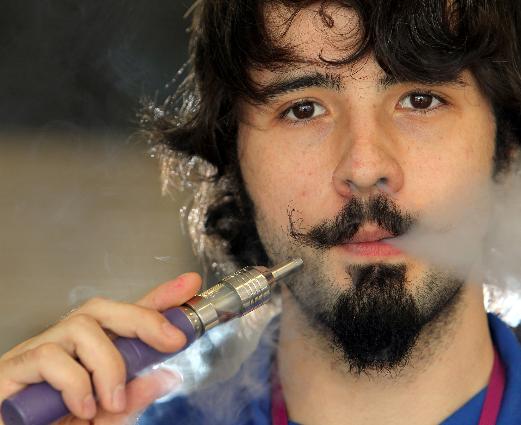Are e-cigarettes healthier?
By Joe Callahan
John Sweet once smoked two packs of cigarettes per day until a chance visit to a Clearwater flea market in early May led him to the latest nicotine alternative.
For $50 he purchased a battery-powered electronic cigarette — a device that comes in many shapes and sizes and in different price ranges.
With the push of a button, the e-cigarette heats a nicotine-infused propylene glycol fluid, turning it into a vapor that’s inhaled. E-cigarette users call the act “vaping,” not smoking.
These e-cigarettes, or e-cigs for short, often look like real cigarettes, but without the lingering smoky odor. Other devices — invented and manufactured in China — look like large ink pens.
“On the spot (after seeing the e-cigarette), I decided to quit,” Sweet said.
Sweet, 44, last week upgraded his cheaper realistic-looking e-cig at Johnny Vapenhiemer E-Cigs, a Paddock Mall kiosk. He said the cheaper e-cig had a short battery life and he wanted something better.
Sweet loves vaping because it is one-fifth the cost of smoking. And despite health warnings, it’s healthier than smoking traditional cigarettes, he said.
In June, the Food and Drug Administration in the Philippines issued an advisory, warning that e-cigs have not been tested and second-hand emissions could be harmful.
“E-cigarettes contain volatile substances, including popylene glycol, flavors and nicotine, and are emitted as (a) mist or aerosol into indoor air,” according to the June 26 advisory.
The advisory stated the FDA in that country cannot exclude adverse health risks from second-hand emission exposure. However, that agency conceded that e-cig devices produce fewer harmful chemicals than conventional cigarettes.
In the United States, the FDA is moving to release for public comment a proposed rule to regulate additional categories of tobacco products, such as e-cigarettes. FDA officials said they cannot comment on the contents of the proposed rule. Official noted in a statement that “further research is needed to assess the potential public health benefits and risks of electronic cigarettes and other novel tobacco products.”
At the e-cig kiosk in Paddock Mall, owner Johnny Mays — who calls himself Johnny Vapor, master vaporologist — defended the world’s fastest-growing tobacco trend.
Mays held a 48-page e-cigarette study commissioned by the Tobacco Vapor Electronic Cigarette Association (TVECA).
He inhaled an e-cig, one of two that comes in a kit with a battery charger and bottle of fluid, called e-juice, for $64.95. Mays carries e-juice in 60-plus flavors, from tobacco to strawberry.
Users squirt a few drops of fluid into a small tank. The battery heats the e-juice to 92 degrees. With a push of a button, users inhale vapor through a mouthpiece.
Mays says the industry is misunderstood and that e-cigs are much safer than traditional cigarettes.
“Cigarettes have thousands of harmful chemicals; e-juice has one chemical,” Mays said as he helped Sweet pick a red e-cigarette kit.
June’s advisory came three years after the agency attempted to block the sale of e-cigarettes all together in the United States. The FDA claimed that an e-cigarette was a drug device and should be regulated as a heavily scrutinized medicine, not a tobacco product.
The federal court ruled e-cigarettes do fall under the FDA’s tobacco regulations. After all, nicotine comes from the leaf and stems of tobacco.
Tom Kiklas, co-founder of TVECA, maintains that e-cigarettes are not being touted as a cessation product, like nicotine lozenges, patches and gum. Therefore, e-cigs can be marketed like any other tobacco product.
The American Lung Association doesn’t buy Kiklas’ claims. Erika Sward, American Lung Association’s vice president of national advocacy, said e-cigs have not been thoroughly studied and no one really knows the chemical content in the e-juice. She also criticized the FDA and the Obama Administration for not moving fast enough in regulating e-cigarettes.
“The American Lung Association is very concerned about the potential health impacts of e-cigarettes,” said Sward, adding another big concern is the product is being marketed to children. “When I see a product with a cotton candy flavor, I don’t think that is for adults.”
Sward said there is also ample proof that e-cigarette companies are marketing the products as a tobacco cessation aide.
Kiklas said manufacturers of cessation products, not the tobacco industry, is leading the charge against e-cigarettes. Most tobacco manufacturers are — or soon will be — joining the e-cigarette market after tobacco sales declined by 5 percent last year.
Kiklas said regular tobacco cigarettes have 7,000 chemicals, 600 of which become carcinogens when ignited. E-cigarettes only have five basic ingredients: nicotine, flavoring, water, glycerol and propylene glycol — less than one half of 1 percent of the harmful chemicals, he said. Propylene glycol has caused concern among e-cig opponents because it is an ingredient in anti-freeze. Kiklas said the ingredient, which has long been approved by the FDA, is in many products, including asthma inhalers and food since the 1930s.
Health officials said since the product is not regulated — or even properly studied — then who knows officially what e-juice contains from one manufacturer to another. The Florida Department of Health’s Tobacco Free Florida agency stated it “is wary of any perceived benefits.” The agency noted there is no credible medical or scientific research to support the safety of e-cigs.
“Preliminary research from the FDA revealed that some e-cigarettes contain toxic substances and carcinogens, which are known to cause cancer,” the state health department noted.
The group Americans for Nonsmoker’ Rights (ANR) cited the Indoor Air journal study. The study showed nicotine causes the formation of carcinogens — including formaldehyde — when exhaled indoors, and could remain on surfaces for weeks. Users could then absorb the carcinogens.
“The authors (of the study) concluded the e-cigarettes are a new source of chemical and aerosol exposure and their potential impact is a concern that should be investigated,” the statement noted.
ANR’s immediate concern is the use of e-cigs at smokefree locations, like the workplaces and restaurants.
Evelyn James, health education specialist with the Florida Department of Health in Marion County (once called the Marion County Health Department), said e-cigarettes have not been studied.
James urged potential users not to “replace one product that has been proven to be bad for you” for another that has not even been tested.
The FDA’s June advisory comes as the popularity of e-cigarettes is starting to gain worldwide momentum.
E-cigarettes is a $500 million industry, a minute share of the annual $80 billion U.S. tobacco market. The e-cigarette market has grown globally by 30 percent in the past three consecutive years.
Marion County resident Jan Spagnol, an opiate user who has been clean for one year, said during her recovery, she has relied heavily on cigarettes. Last week, she purchased an e-cig kit from Mays to ratchet down her nicotine intake.
E-juice comes in different strengths, ranging from 24 milligrams of nicotine per milliliter down to zero. One 12 milliliter bottle, which costs $8.99 at the Paddock Mall kiosk, will last a one-pack-per-day light cigarette smoker about two weeks.
The e-cigarette device itself can be reused. The consumer will also have to buy a replacement tank for $6.99 about once a month, depending on usage.
In the end, a one-pack-per-day light cigarette smoker will spend about $25 per month vaporing, compared to about $150 per month smoking.
“I wanted a way to wean myself off cigarettes,” she said, adding that nicotine patches was one option.
She decided against patches because e-cigarettes allow her to still inhale and exhale, retaining that oral fixation associated with cigarettes.
“After I quit smoking, I really will be clean and sober,” she noted.
http://www.ocala.com/article/20130717/ARTICLES/130719745/-1/entertainment02?p=5&tc=pg




